In the current world, the demand for consumer spending has significantly increased. Now more than ever, manufacturers and e-commerce businesses need to enhance their productivity through automated material handling processes. In this comprehensive article, we will define 'material handling,' explore how to automate your material handling application, and discuss the associated benefits.
What is material handling?

The dictionary defines material handling as 'the loading, unloading, and movement of goods, as within a factory or warehouse, especially with the aid of mechanical devices.' While this is a good starting point, it encompasses more than just managing inventory. Material handling involves the movement, protection, storage, and control of materials and products throughout their entire lifecycle, encompassing manufacturing, warehousing, distribution, consumption, and disposal. In a logistics environment, material handling essentially governs the flow of a given product from its origin to its destination.
The necessity of automation in material handling
In the past, due to the lack of effective technology, all material handling tasks were carried out manually. Workers relied on their physical strength to lift, carry, and transfer materials and products within a warehouse or building. However, manual material handling often involves strenuous physical labor, increasing the likelihood of workplace accidents and slowing down production processes.
Nowadays, with the continually increasing demand in logistics, especially in the wake of the pandemic, more companies are turning to automated equipment. Over the past two years, we've witnessed a surge in demand driven by e-commerce, and this growth is expected to continue through 2025.
'Automation' used to be a daunting term, often associated with concerns about unemployment among assembly line workers and the rise of robots. However, thanks to ever-advancing technology, automation is becoming increasingly mainstream. The shortage of low-skilled labor has prompted manufacturers to invest in automation, leading to the need for human reskilling and upskilling. In automated material handling, robots and other advanced computerized devices are utilized to move, lift, store, or retrieve products and materials. In this form of material handling, all tasks are performed by automated equipment. Workers, on the other hand, are primarily responsible for overseeing and controlling the processes executed by machinery. Consequently, among other benefits, the automation of material handling significantly reduces the risks of workplace accidents.
The benefits of automated material handling
The benefits of automated material handling include:
Increased Efficiency: Automation speeds up material handling processes, reducing production cycle times and improving overall operational efficiency.
Enhanced Accuracy: Automated systems are highly precise, minimizing errors in tasks like picking, sorting, and inventory management.
Improved Safety: Automation reduces the need for manual labor in strenuous and potentially hazardous tasks, leading to a safer working environment.
Cost Savings: Automation reduces labor costs, enhances resource utilization, and minimizes the risk of product damage, resulting in cost savings.
Scalability: Automated systems can adapt to changing production demands, making it easier to scale operations as needed.
24/7 Operations: Automated systems can work continuously, enabling round-the-clock operations without fatigue or breaks.
Space Optimization: Automated storage and retrieval systems (AS/RS) can maximize the use of available space in warehouses.
Inventory Control: Automated systems provide real-time inventory tracking and control, reducing stockouts and overstock situations.
Streamlined Processes: Material handling automation streamlines workflows, leading to smoother production and distribution processes.
Competitive Advantage: Embracing automation can provide a competitive edge by enabling faster response times and higher product quality.
These benefits make automated material handling a valuable investment for various industries.
Conclusion
Thanks to the versatile automated material handling solutions offered by Mech-Mind, companies can substantially enhance their customers' operations and overall company profitability. Furthermore, implementing the appropriate material handling solutions, along with the support of 3D cameras and AI software, enables significant cost savings while concurrently boosting workplace safety and production efficiency.
Robotics are essential to industrial automation, and using robots provides organizations with a competitive edge. Advanced robotics and innovation are the focus of Mech-Mind’s products and solutions. Since every company is unique, it also requires a unique solution that matches its needs. If you are considering improving your current material handling solution, Mech-Mind is here to answer any questions you might have considering the automation of your warehouse and assist you in choosing an industrial robot or a cobot that will perform best for your working procedures.